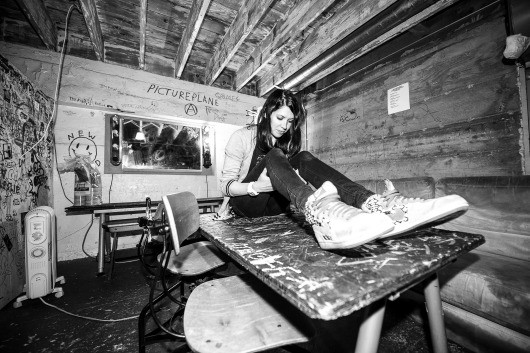
Kristine Flaherty's entire career started off as a dare. It was around the end of her freshman year at Stanford University, and she and a friend were hanging out in a dorm room, talking about the condition of mainstream hip-hop–a style Flaherty felt had become cookie-cutter. “I was just complaining about that, and he challenged me to make a song,” Flaherty, 28, says.
Flaherty penned a parody track called “Blingity Blang Blang” that she thoroughly enjoyed putting together. From there, she wrote a few more parodies. By the following summer, she was designing her own beats and writing more sincere verses–all of which eventually led to her playing shows on campus as K.Flay (a nickname from her college days). “The whole time, it was a very genuine but random and innocent type of thing. I started to think about it in a serious way after I graduated college,” she says. “I had just gone through a breakup and I was trying to figure out what the hell I was doing with my life. I think I started making music that was a little bit more emotionally resonant. When that happened, something kind of clicked in my brain.”
]
At this point, Flaherty is so dedicated to the K.Flay cause that she doesn't technically have a home. The closest thing to her own space is a storage unit in Yonkers, New York, that's housing her stuff while she lives on the road. She has yet to put out a full-length album and doesn't quite know when she'll throw one out there. In the meantime, she has picked mixtapes and EPs as her poison. August's What If It Is is her latest, and that release's “Rawks” provides a solid primer on K.Flay's style. The track probes scattered images of strangers and apathetic/indecisive moments in her own life, all while taking a hard look at herself–and she finds she isn't too pleased.
Sonically, Flaherty's sleek, throbbing beats draw much from indie rock and electronic music. Though her voice and flow run along the same currents as Dessa, Macklemore and Aesop Rock–indie hip-hop sorts who are prone to self-analysis, intellectualized lyri-cism and breathless cadence–she's also responsible for “Party,” off her 2011 mixtape I Stopped Caring in '96. For that, K.Flay fol-lows the same mold as Dr. Seuss' Green Eggs and Ham and Limp Bizkit's “Hot Dog” (for real) by mapping out a simple template and filling in the blanks with whatever rhymes come to mind:
“Party with a mission, party with a condom/Party like a monk, party like John Bonham/Party with a turtle/Party in a line, a square, a circle.”
“Party” skirts the line between championing the right to party, mocking excess and celebrating for celebration's sake. It's futile to distinguish them, but that's central to the song's charm.
[
With her name still on the rise, a significant chunk of public interest in K.Flay is rooted in the novelty of her background. Aside from her stint at Stanford (where she majored in psychology and sociology), she's also white, a woman and originally from the upscale Chicago suburb of Wilmette. A 2012 Time Out Chicago story went the whole hog on building her up based on her background, calling her “rap's great white, female hope,” but Flaherty is less than enthusiastic about such a designation.
“I hope I'm nobody's great hope in any capacity,” she says with a chuckle. “There's still something novel about a white girl rapping, but I hope the different releases I've put out extend beyond that label. Obviously, I am rapping at points, but there are songs on which I only sing and there are songs on the indie side of things. I see the project speaking a bit broader than that, but yeah, I shouldn't be anybody's hope.”
K.Flay performs with Icona Pop and Sirah at the Observatory, 3503 S. Harbor Blvd., Santa Ana, (714) 957-0600; www.observatoryoc.com. Tues., 8 p.m. $20. All ages.
Follow us on Twitter @OCWeeklyMusic and like us on Facebook at Heard Mentality.

